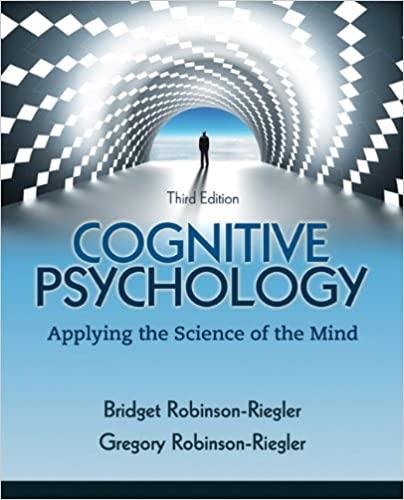Question
THE TEXT : Elaborative rehearsal is a memory technique that involves actively thinking about and connecting new information with existing knowledge in order to make
THE TEXT :
Elaborative rehearsal is a memory technique that involves actively thinking about and connecting new information with existing knowledge in order to make it more meaningful and easier to remember. There are several ways to use elaborative rehearsal: Creating associations: Connecting new information with something familiar or meaningful can help make it more memorable. For example, if you are trying to remember a list of grocery items, you could associate each item with a room in your house, such as milk with the fridge and bread with the pantry. Visualizing information: Creating mental images or visual representations of information can also help make it more memorable. For example, if you are trying to remember a historical date, you could visualize the events that occurred on that day. Organizing information: Breaking information down into smaller, more manageable chunks can make it easier to remember. For example, if you are trying to remember a long list of numbers, you could group them into sets of three or four. Generating examples: Coming up with examples or applying new information to real-life situations can help make it more meaningful and memorable. For example, if you are learning a new math concept, you could apply it to a real-life problem or situation.
2,
Empirical research has been conducted on various psychological problems and phenomena. One such study was conducted by Bargh and colleagues (1996), who investigated the effects of priming on social behavior. In the study, participants were primed with words related to either rudeness or politeness before engaging in a conversation with a confederate. The researchers found that participants who were primed with rude words were more likely to interrupt the confederate and engage in other impolite behaviors, while those who were primed with polite words behaved more courteously. The study demonstrated the power of priming on social behavior and provided insights into the role of automatic processes in social interactions. Bargh, J. A., Chen, M., & Burrows, L. (1996). Automaticity of social behavior: Direct effects of trait construct and stereotype-activation on action. Journal of Personality and Social Psychology, 71(2), 230-244. doi:10.1037/0022-3514.71.2.230
QUESTION :
Evaluate the research presented. Examine the strengths and weaknesses of the study.
Include at least 2 strengths and weaknesses of the study.
Step by Step Solution
There are 3 Steps involved in it
Step: 1

Get Instant Access to Expert-Tailored Solutions
See step-by-step solutions with expert insights and AI powered tools for academic success
Step: 2

Step: 3

Ace Your Homework with AI
Get the answers you need in no time with our AI-driven, step-by-step assistance
Get Started


